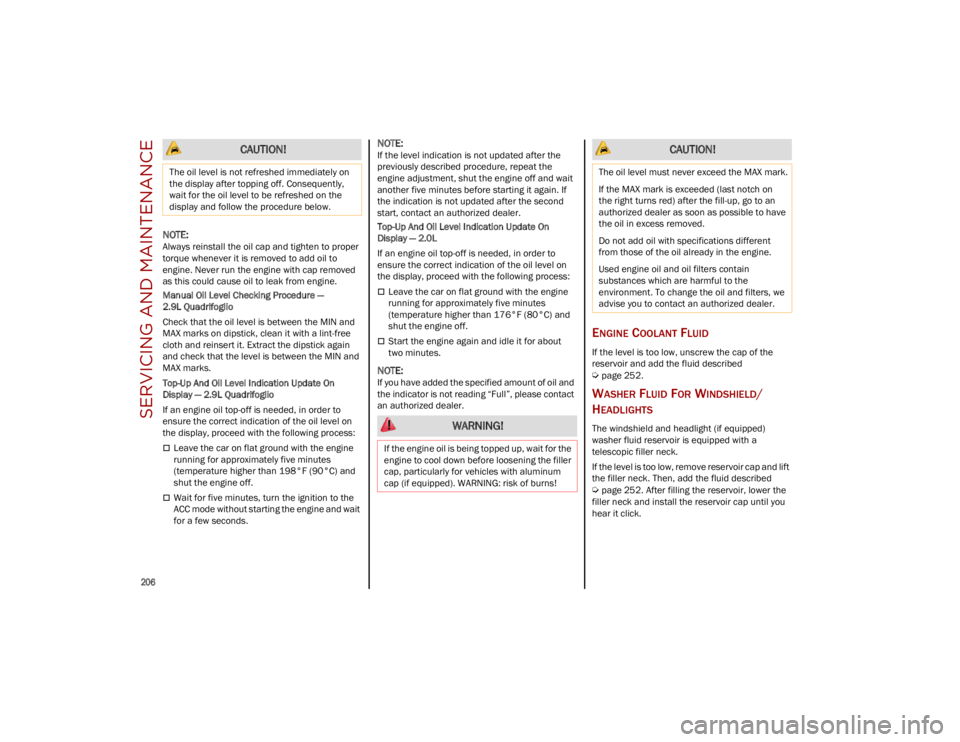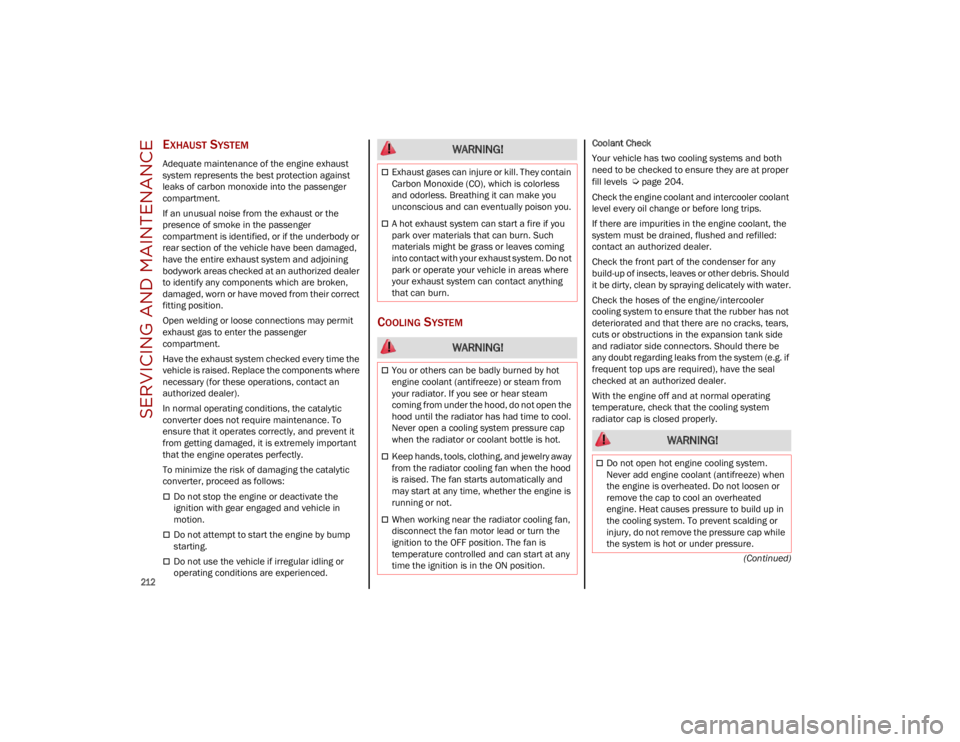2023 ALFA ROMEO STELVIO coolant temperature
[x] Cancel search: coolant temperaturePage 208 of 268

SERVICING AND MAINTENANCE
206
NOTE:
Always reinstall the oil cap and tighten to proper
torque whenever it is removed to add oil to
engine. Never run the engine with cap removed
as this could cause oil to leak from engine.
Manual Oil Level Checking Procedure —
2.9L Quadrifoglio
Check that the oil level is between the MIN and
MAX marks on dipstick, clean it with a lint-free
cloth and reinsert it. Extract the dipstick again
and check that the level is between the MIN and
MAX marks.
Top-Up And Oil Level Indication Update On
Display — 2.9L Quadrifoglio
If an engine oil top-off is needed, in order to
ensure the correct indication of the oil level on
the display, proceed with the following process:
Leave the car on flat ground with the engine
running for approximately five minutes
(temperature higher than 198°F (90°C) and
shut the engine off.
Wait for five minutes, turn the ignition to the
ACC mode without starting the engine and wait
for a few seconds.
NOTE:
If the level indication is not updated after the
previously described procedure, repeat the
engine adjustment, shut the engine off and wait
another five minutes before starting it again. If
the indication is not updated after the second
start, contact an authorized dealer.
Top-Up And Oil Level Indication Update On
Display — 2.0L
If an engine oil top-off is needed, in order to
ensure the correct indication of the oil level on
the display, proceed with the following process:
Leave the car on flat ground with the engine
running for approximately five minutes
(temperature higher than 176°F (80°C) and
shut the engine off.
Start the engine again and idle it for about
two minutes.
NOTE:
If you have added the specified amount of oil and
the indicator is not reading “Full”, please contact
an authorized dealer.
ENGINE COOLANT FLUID
If the level is too low, unscrew the cap of the
reservoir and add the fluid described
Ú
page 252.
WASHER FLUID FOR WINDSHIELD/
H
EADLIGHTS
The windshield and headlight (if equipped)
washer fluid reservoir is equipped with a
telescopic filler neck.
If the level is too low, remove reservoir cap and lift
the filler neck. Then, add the fluid described
Ú
page 252. After filling the reservoir, lower the
filler neck and install the reservoir cap until you
hear it click.
CAUTION!
The oil level is not refreshed immediately on
the display after topping off. Consequently,
wait for the oil level to be refreshed on the
display and follow the procedure below.
WARNING!
If the engine oil is being topped up, wait for the
engine to cool down before loosening the filler
cap, particularly for vehicles with aluminum
cap (if equipped). WARNING: risk of burns!
CAUTION!
The oil level must never exceed the MAX mark.
If the MAX mark is exceeded (last notch on
the right turns red) after the fill-up, go to an
authorized dealer as soon as possible to have
the oil in excess removed.
Do not add oil with specifications different
from those of the oil already in the engine.
Used engine oil and oil filters contain
substances which are harmful to the
environment. To change the oil and filters, we
advise you to contact an authorized dealer.
23_GU_OM_EN_USC_t.book Page 206
Page 214 of 268

SERVICING AND MAINTENANCE
212
(Continued)
EXHAUST SYSTEM
Adequate maintenance of the engine exhaust
system represents the best protection against
leaks of carbon monoxide into the passenger
compartment.
If an unusual noise from the exhaust or the
presence of smoke in the passenger
compartment is identified, or if the underbody or
rear section of the vehicle have been damaged,
have the entire exhaust system and adjoining
bodywork areas checked at an authorized dealer
to identify any components which are broken,
damaged, worn or have moved from their correct
fitting position.
Open welding or loose connections may permit
exhaust gas to enter the passenger
compartment.
Have the exhaust system checked every time the
vehicle is raised. Replace the components where
necessary (for these operations, contact an
authorized dealer).
In normal operating conditions, the catalytic
converter does not require maintenance. To
ensure that it operates correctly, and prevent it
from getting damaged, it is extremely important
that the engine operates perfectly.
To minimize the risk of damaging the catalytic
converter, proceed as follows:
Do not stop the engine or deactivate the
ignition with gear engaged and vehicle in
motion.
Do not attempt to start the engine by bump
starting.
Do not use the vehicle if irregular idling or
operating conditions are experienced.
COOLING SYSTEM
Coolant Check
Your vehicle has two cooling systems and both
need to be checked to ensure they are at proper
fill levels
Ú
page 204.
Check the engine coolant and intercooler coolant
level every oil change or before long trips.
If there are impurities in the engine coolant, the
system must be drained, flushed and refilled:
contact an authorized dealer.
Check the front part of the condenser for any
build-up of insects, leaves or other debris. Should
it be dirty, clean by spraying delicately with water.
Check the hoses of the engine/intercooler
cooling system to ensure that the rubber has not
deteriorated and that there are no cracks, tears,
cuts or obstructions in the expansion tank side
and radiator side connectors. Should there be
any doubt regarding leaks from the system (e.g. if
frequent top ups are required), have the seal
checked at an authorized dealer.
With the engine off and at normal operating
temperature, check that the cooling system
radiator cap is closed properly.
WARNING!
Exhaust gases can injure or kill. They contain
Carbon Monoxide (CO), which is colorless
and odorless. Breathing it can make you
unconscious and can eventually poison you.
A hot exhaust system can start a fire if you
park over materials that can burn. Such
materials might be grass or leaves coming
into contact with your exhaust system. Do not
park or operate your vehicle in areas where
your exhaust system can contact anything
that can burn.
WARNING!
You or others can be badly burned by hot
engine coolant (antifreeze) or steam from
your radiator. If you see or hear steam
coming from under the hood, do not open the
hood until the radiator has had time to cool.
Never open a cooling system pressure cap
when the radiator or coolant bottle is hot.
Keep hands, tools, clothing, and jewelry away
from the radiator cooling fan when the hood
is raised. The fan starts automatically and
may start at any time, whether the engine is
running or not.
When working near the radiator cooling fan,
disconnect the fan motor lead or turn the
ignition to the OFF position. The fan is
temperature controlled and can start at any
time the ignition is in the ON position.
WARNING!
Do not open hot engine cooling system.
Never add engine coolant (antifreeze) when
the engine is overheated. Do not loosen or
remove the cap to cool an overheated
engine. Heat causes pressure to build up in
the cooling system. To prevent scalding or
injury, do not remove the pressure cap while
the system is hot or under pressure.
23_GU_OM_EN_USC_t.book Page 212
Page 262 of 268

260
INDEX
A
Accessories Purchased By The Owner.......... 4
Active Blind Spot Assist .............................146
Active Safety Systems ................................ 140
Active Speed Limiter ..................................101
Active Torque Vectoring (ATV) System ......140
Adaptive Cruise Control (ACC)
(Cruise Control) .................................102, 105Off ........................................................... 106
On............................................................106
Additives, Fuel ............................................ 250
Adjust Forward.............................................. 31, 34
Rearward ........................................... 31, 34
Air Bag......................................................... 163 Air Bag Operation ...................................165Air Bag Warning Light ............................162
Driver Knee Air Bag................................ 165Enhanced Accident Response .....168, 198
Event Data Recorder (EDR) ...................198
Front Air Bag...........................................163
If Deployment Occurs ............................167
Knee Impact Bolsters ............................165
Maintaining Your Air Bag System.......... 170
Maintenance ..........................................170
Redundant Air Bag Warning Light.........163
Side Air Bags ..........................................165
Transporting Pets...................................180
Air Bag Light ......................................162, 180
Air Pressure Tires ........................................................230
Alfa Active Suspension (AAS)....................... 99
Alfa DNA System .......................................... 97
Antifreeze (Engine Coolant) ....................... 251
Anti-Lock Braking (ABS) System ................ 140 Anti-Lock Warning Light ...............................76
Automatic Climate Controls .........................50
Automatic Dimming Mirror...........................38
Automatic Door Locks ..................................28
Automatic Headlights ...................................44
Automatic Temperature Control (ATC) ........50
Automatic Transmission ..............................91
Auxiliary Driving Systems .......................... 144
Auxiliary Power Outlet ..................................57
B
Battery ..................................................79, 207 Charging System Light .............................79
Keyless Key Fob Replacement ................20
Battery Recharging .................................... 208
Belts, Seat .................................................. 180
Blind Spot Monitoring ............................... 144
Bodywork (Cleaning And Maintenance) ... 239
B-Pillar Location......................................... 227
Brake System Warning Light .................................... 75, 76
Brakes ........................................................ 244 Brake Fluid Level................................... 207
Brightness, Interior Lights............................47
Bulbs, Light ................................................ 182
C
Camera, Rear ............................................. 128
Capacities, Fluid ........................................ 251
Carbon Monoxide Warning ....................... 182
Cargo Compartment .....................................66
Certification Label ..................................... 132
Chart, Tire Sizing........................................ 225
Check Engine Light
(Malfunction Indicator Light) .......................85 Checking Levels ................................ 204, 205
Checking Your Vehicle For Safety ............. 180
Checks, Safety ........................................... 180
Child Restraint ........................................... 170
Child Restraints
Booster Seats ........................................ 173
Child Seat Installation ........................... 178
How To Stow An unused ALR Seat Belt ..................................... 176
Infant And Child Restraints ................... 172
LATCH Positions ..................................... 174
Lower Anchors And Tethers For Children ....................................... 174
Older Children And Child Restraints ..... 172
Seating Positions ................................... 173
Clean Air Gasoline ..................................... 249
Cleaning Wheels.................................................... 235
Climate Control ......................................49, 55 Automatic ................................................. 50
Compact Spare Tire ................................... 234
Contract, Service........................................ 257
Cooling System Cooling Capacity .................................... 251
Selection Of Coolant (Antifreeze) ......... 251
Cruise Control (Speed Control) ........ 102, 105
Customer Assistance ................................. 255
D
Daytime Running Lights .............................. 43
Defroster, Windshield ................................ 180
Dimensions ................................................ 246
Disabled Vehicle Towing............................ 196
Door Ajar.................................................79, 80
Door Ajar Light .......................................79, 80
23_GU_OM_EN_USC_t.book Page 260